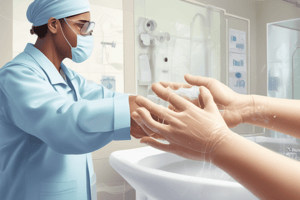Podcast
Questions and Answers
What is the primary aim of handwashing in clinical settings?
What is the primary aim of handwashing in clinical settings?
- To prevent infection by removing microorganisms (correct)
- To speed up the healing process of wounds
- To promote hand softness and moisturize the skin
- To remove dirt and debris from the hands
Why is hand hygiene considered crucial for both patients and staff?
Why is hand hygiene considered crucial for both patients and staff?
- To protect against the transmission of infections (correct)
- To improve the scent of hands
- To ensure hands are always dry and smooth
- To make the hands look visually appealing
What is the recommended duration for washing hands with soap and water?
What is the recommended duration for washing hands with soap and water?
- 5-10 seconds
- 15-20 seconds (correct)
- 1 minute
- 30-40 seconds
How does handwashing in clinical settings differ from regular handwashing?
How does handwashing in clinical settings differ from regular handwashing?
What is the main purpose of good hand hygiene according to the text?
What is the main purpose of good hand hygiene according to the text?
What is the key reason for performing surgical handwashing?
What is the key reason for performing surgical handwashing?
How long does a typical medical handwashing procedure last?
How long does a typical medical handwashing procedure last?
What are the Five Key Situations described by WHO (the 5 moments in Hand Hygiene)?
What are the Five Key Situations described by WHO (the 5 moments in Hand Hygiene)?
What is the main cleaning agent used in hand washing?
What is the main cleaning agent used in hand washing?
What should be done with jewelry before starting the handwashing procedure?
What should be done with jewelry before starting the handwashing procedure?
Why is it recommended that nothing is worn below the elbow during handwashing?
Why is it recommended that nothing is worn below the elbow during handwashing?
What should be done after regulating the water temperature?
What should be done after regulating the water temperature?
Why is it important to keep hands lower than elbows during handwashing?
Why is it important to keep hands lower than elbows during handwashing?
How long should the friction motion during handwashing be continued?
How long should the friction motion during handwashing be continued?
What should be used to clean under fingernails during handwashing?
What should be used to clean under fingernails during handwashing?
Why is it recommended to rinse thoroughly with water flowing towards fingertips?
Why is it recommended to rinse thoroughly with water flowing towards fingertips?
What should be done after patting hands dry with a paper towel?
What should be done after patting hands dry with a paper towel?
Flashcards are hidden until you start studying
Study Notes
Hand Hygiene in Clinical Settings
- The primary aim of handwashing in clinical settings is to prevent the transmission of infectious diseases and microorganisms.
- Hand hygiene is crucial for both patients and staff to prevent healthcare-associated infections (HAI) and to reduce the risk of cross-infection.
Handwashing Technique
- The recommended duration for washing hands with soap and water is at least 15-30 seconds.
- Handwashing in clinical settings differs from regular handwashing in that it requires a more thorough and systematic approach to ensure removal of all dirt, microorganisms, and transient flora.
Purpose of Hand Hygiene
- The main purpose of good hand hygiene is to reduce the risk of transmission of microorganisms and to prevent HAI.
Surgical Handwashing
- The key reason for performing surgical handwashing is to prevent surgical site infections (SSIs).
Handwashing Procedure
- A typical medical handwashing procedure can last around 40-90 seconds.
- The Five Key Situations described by WHO (the 5 moments in Hand Hygiene) are: 1) before patient contact, 2) before an aseptic task, 3) after body fluid exposure risk, 4) after patient contact, and 5) after contact with patient surroundings.
- Soap and water are the main cleaning agents used in hand washing.
- Jewelry should be removed before starting the handwashing procedure to prevent bacterial accumulation.
- Nothing should be worn below the elbow during handwashing to prevent bacterial colonization.
- After regulating the water temperature, wet hands with warm water.
- Hands should be kept lower than elbows during handwashing to prevent water from flowing back up the arms.
- The friction motion during handwashing should be continued for at least 15-30 seconds.
- A nail brush or nailpick should be used to clean under fingernails during handwashing.
- Hands should be rinsed thoroughly with water flowing towards fingertips to prevent bacteria from flowing back up the arms.
- After patting hands dry with a paper towel, turn off the faucet with a paper towel to prevent re-contamination.
Studying That Suits You
Use AI to generate personalized quizzes and flashcards to suit your learning preferences.




